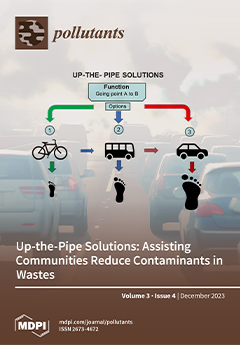Regulatory monitoring networks are often too sparse to support community-scale PM
2.5 exposure assessment, while emerging low-cost sensors have the potential to fill in the gaps. Recent advances in air quality monitoring have produced portable, easy-to-use, low-cost, sensor-based monitors which have given a
[...] Read more.
Regulatory monitoring networks are often too sparse to support community-scale PM
2.5 exposure assessment, while emerging low-cost sensors have the potential to fill in the gaps. Recent advances in air quality monitoring have produced portable, easy-to-use, low-cost, sensor-based monitors which have given a new dimension to air pollutant monitoring and have democratized the air quality monitoring process by making monitors and results directly available at the community level. This study used PurpleAir © sensors for PM
2.5 assessment in California, USA. The evaluation of PM
2.5 from sensors included Quality Assurance and quality control (QA/QC) procedures, assessment concerning reference-monitored PM
2.5 concentrations, and the formulation of a decision support system integrating these observations using geostatistical techniques. The hourly and daily average observed PM
2.5 concentrations from PurpleAir monitors followed the trends of observed PM
2.5 at regulatory monitors. PurpleAir monitors also captured the peak PM
2.5 concentrations due to incidents such as forest fires. In comparison with reference-monitored PM
2.5 levels, it was found that PurpleAir PM
2.5 concentrations were mostly higher. The most important reason for PurpleAir’s higher PM
2.5 concentrations was the inclusion of moisture or water vapor as an aerosol in contrast to measurements of PM
2.5 excluding water content in FEM/FRM and non-FEM/FRM monitors. Long-term assessment (2016–2023) revealed that R
2 values were between 0.54 and 0.86 for selected collocated PurpleAir sensors and regulatory monitors for hourly PM
2.5 concentrations. Past research studies that were conducted for mostly shorter periods resulted in higher R
2 values between 0.80 and 0.98. This study aims to provide reasonable estimations of PM
2.5 concentrations with high spatiotemporal resolutions based on statistical models using PurpleAir measurements. The methods of Kriging and IDW, geostatistical interpolation techniques, showed similar spatio-temporal patterns. Overall, this study revealed that low-cost, sensor-based PurpleAir sensors could be effective and reliable tools for episodic and long-term ambient air quality monitoring and developing mitigation strategies.
Full article



